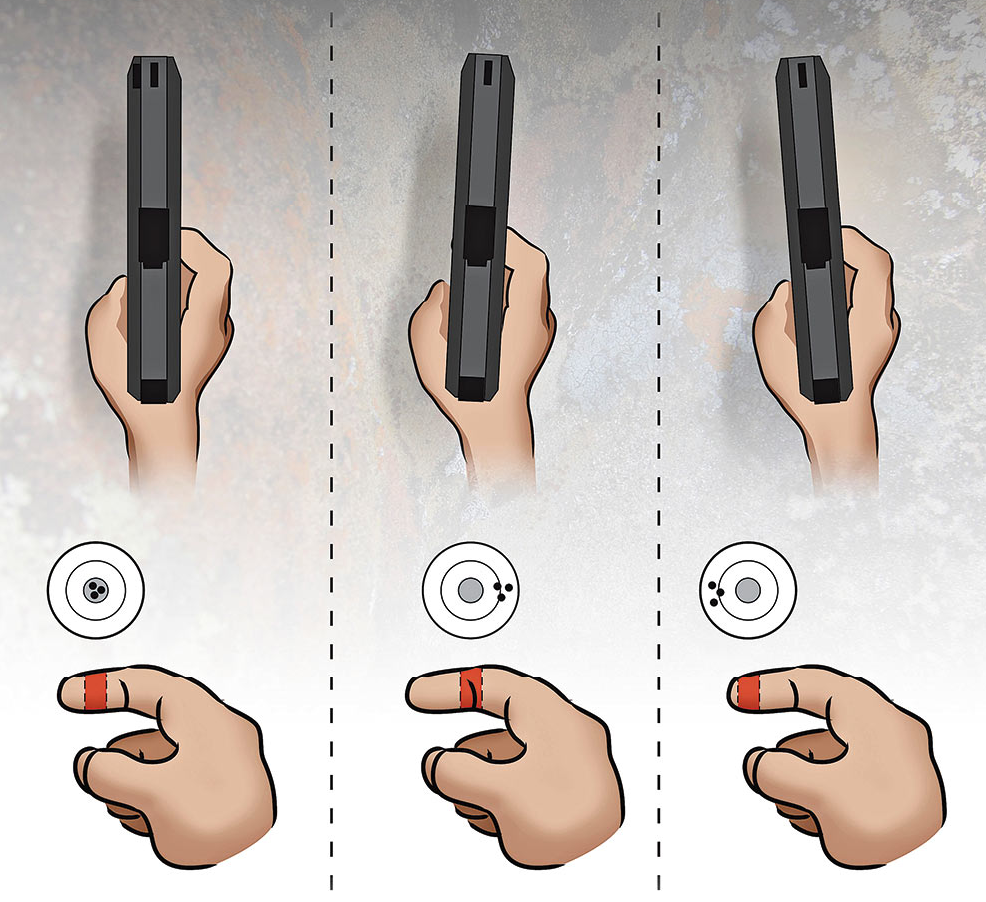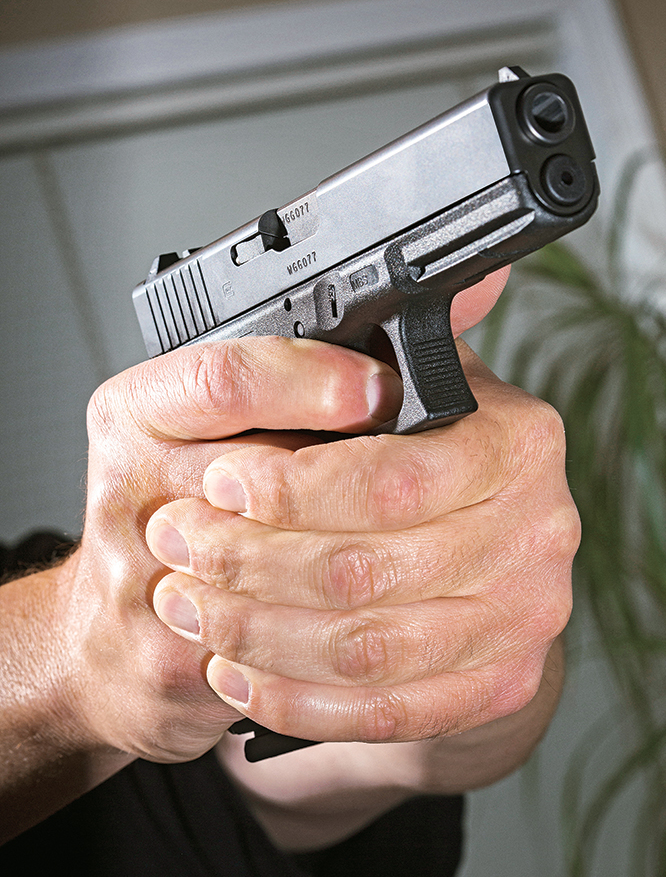Like a Glove: Picking a Handgun to Fit Your Grip
31st Jul 2014

Forget caliber, brand and all that stuff. The first important step in buying a defensive handgun is finding one that fits.
Grip, one of the fundamentals of marksmanship, is a determining factor in your ability to shoot, operate and control your handgun. Since grip is the interface between you and your gun, it’s important to select a handgun that fits your hand properly. A gun’s weight and caliber are also important considerations. One thing is certain. When it comes to defensive handguns, one size does not fit all.
When you get behind the wheel of a vehicle you haven’t driven before, you’ll probably adjust the seat, rear and side view mirrors and maybe even the steering wheel. This not only ensures a more comfortable driving experience but also actually makes for a safer one.
For instance, you can more easily bring the vehicle to a stop when you don’t have to stretch to reach the brake pedal. In the same vein, if you have to duck your head to avoid the roof while in the driver’s seat, you’re likely to fatigue more quickly than if you were comfortably seated. Obviously, there are countless other examples of ergonomics improving driver comfort and performance, but you get the point.
In some respects, the automotive industry is light years ahead of the firearms industry. Only recently have major gun manufacturers offered options to accommodate different hand sizes. Now, thanks to reversible or interchangeable backstraps, a pistol such as a Ruger SR45 or a Smith & Wesson M&P can easily accommodate the vast majority of hand sizes and shooter preferences right out of the box.
Still, some guns are no better suited for a particular shooter than a Smart car is for an NBA center. For example, if you have hands the size of a catcher’s mitt, a pocket .380 like the Ruger LCP may not be the best choice.
On the square range with paper targets and relatively little stress, shooting a handgun accurately is challenging. Add to the mix the adrenaline dump you’re sure to experience when you’re fighting for your life, and it’s easy to see the importance of having a handgun that you don’t have to struggle with.
The Starting Point
So how can you tell if a handgun is the right size for your hand? When you hold a handgun, place the web of your hand as high on the backstrap as possible and align the gun with your forearm. Gripping the gun in this manner helps tame recoil because the force is absorbed by the skeletal structure of your arm. It’s important to note that even with a two-handed grip, the gun will come out of alignment to some degree (unless you are shooting from a Weaver stance, with your shooting arm at near full extension and your other arm bent).
When a gun is too big for a shooter’s hand, the tendency is to change the orientation of the shooting hand in order to reach the trigger more easily. Unfortunately, this invariably results in the gun’s recoil being absorbed more by the thumb than the large bones of the arm. Not only could this be annoying and prove injurious in the long run, but it also inhibits your ability to effectively control recoil, which means it will take you longer to get back on target after firing. And without a proper grip, you won’t be able to move your trigger finger independently of the rest of your hand, which is an integral component of accurate shooting.
Like grip, trigger control is a fundamental of marksmanship. When your handgun’s sights are properly aligned and overlaid on your target, you will hit what you’re aiming at unless the gun moves as you press the trigger to the rear. Therefore, when shopping for a handgun, make sure you can comfortably reach the trigger without having to shift the gun in your hand.
If you can easily reach the trigger while holding the gun in the prescribed manner, you’re on the right track. There is some dissension as to what specific part of your index finger should be in contact with the face of the trigger. While this is largely a matter of personal preference, the pad of your index finger—between the tip and the first joint—is probably the most common finger placement for shooting a semiautomatic pistol.
However, if you’re shooting a revolver or a semiautomatic pistol with a relatively heavy double-action trigger, you may need to insert your finger up to the first joint in order to have enough leverage to repeatedly fire the weapon.
If the gun you’re holding requires you to stretch your index finger in order to reach the trigger, there’s a good chance your rounds will impact left of your point of aim (assuming you’re right-handed). That’s because with too little finger on the trigger it’s difficult to press the trigger directly rearward. In such a case, your right index finger tends to push the trigger, and therefore the muzzle, to the left.
A right-handed shooter with too much finger on the trigger is likely to experience the opposite problem. He or she will tend to pull the trigger to the right, and consequently, the rounds will impact to the right of the point of aim.
There’s an important bit of terminology to consider regarding trigger manipulation. As a new shooter, I never understood the emphasis on the phrase “press the trigger” because to me it seemed you “pulled” the trigger to fire a gun. An instructor told me the word “press” denoted a more precise movement.
Using the word “press” also accurately describes moving the trigger rearward using the pad of your index finger (like you would press a button). This is in stark contrast to using just the tip of the finger to “push” the trigger or too much of the finger to “pull” the trigger.
Another consideration when it comes to selecting a handgun is the length of the grip. A shorter grip makes a gun is easier to conceal and less likely to print through the fabric of the garment that covers it. The trade-off here is that although it’s easier to conceal, a gun with a grip that doesn’t accommodate your little finger will tend to be less comfortable to shoot and more difficult to control during recoil. For this and a host of other reasons, small guns are easier to carry and harder to shoot than full-size guns.

Before you spend your hard-earned money on a handgun, it’s a good idea to rent a gun of the same model first.
Ideally, your chosen gun will fit your hand so well that you won’t have to compromise the shooting grip, which was established prior to drawing your gun from the holster. If you have to spin the gun in your hand to reach the magazine release, decocker or other controls, the gun is probably too big.
Grip diameter is another concern. The obvious advantage to a double-stack semiautomatic pistol is that it holds considerably more rounds than a single-stack pistol such as a 1911. However, the small grip diameter of the 1911 is a big reason the design remains popular more than 100 years past its inception.
While the 1911’s ergonomics are the stuff of legend, not even America’s pistol is a good fit for everyone. For some, due to hand size or grip preference, it is difficult to maintain sufficient pressure on the grip safety to keep it depressed, and “Ol’ Slabsides” won’t go bang with a grip safety engaged.
Conversely, single-stack magazines, such as those from a 1911, make loading and reloading the pistol easier, especially for people with smaller hands. Conducting a tactical reload, where you are momentarily controlling two magazines with one hand, with a high-capacity double-stack can be difficult for shooters with small hands.
Of course, the best way to tell whether a handgun is a good fit is to actually handle the gun. After ensuring the gun is unloaded, pick a spot on the wall such as a light switch. Orient your body so the light switch is directly in front of you. Close your eyes then punch out your handgun toward the light switch. Now open your eyes. In all likelihood, if the gun felt right in your hand, its muzzle is pointed pretty darn close to light switch. The simple exercise can give you an idea of how a particular gun will point naturally for you.
This brings us to the grip angle debate, which primarily revolves around the Glock and the 1911. Some swear that the 1911’s grip angle facilitates more natural aiming, and while the Glock has a steeper grip angle, I’ve carried a Glock my entire 17-year career as a police officer. I find the Glock comfortable, and I can shoot it well, but I have grown to love the 1911 design as well.
Of course, there are a lot of other grip angles out there on the market. I think the point is to remember that grip angle is just a number. Do your own research and see what feels right for you—then practice.
Small hands might prompt the shooter to select a subcompact pistol. While the small-handed shooter may be able to establish a more comfortable grip on a smaller handgun, it will tend to produce more felt recoil than a larger, heavier gun.
While it makes sense to carry a handgun of a caliber sufficient to stop an assailant who presents a deadly threat, you don’t necessarily have to carry a .45 ACP. With today’s quality defensive ammunition, calibers that were once dismissed as being too diminutive for personal defense—such as the .380 ACP—are now getting a second look.
You’re better off selecting a 9mm that you can shoot accurately and control than a .45 ACP that’s not as easily managed. A hit with a 9mm always beats a miss with a .45 ACP.
Before you spend your hard-earned money on a handgun, it’s a good idea to rent a gun of the same model first. After all, live fire is the best barometer as to whether a particular handgun is a good fit. If it feels good in your hand, you can easily reach all of the controls, hit your target and efficiently manage recoil, you’ve probably found a keeper.
